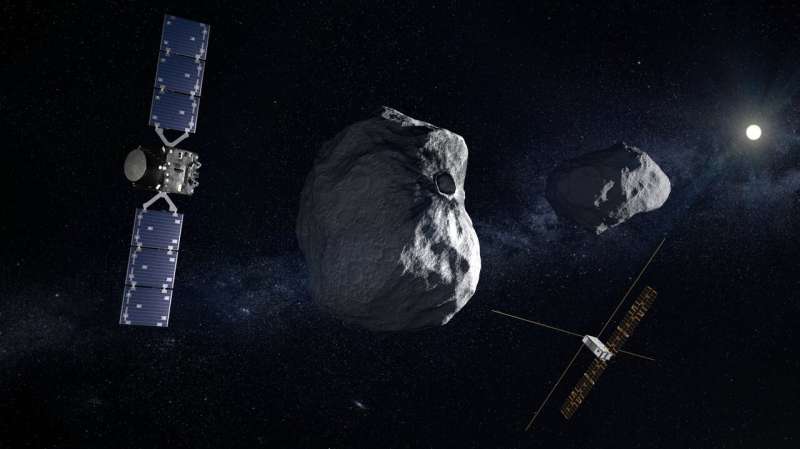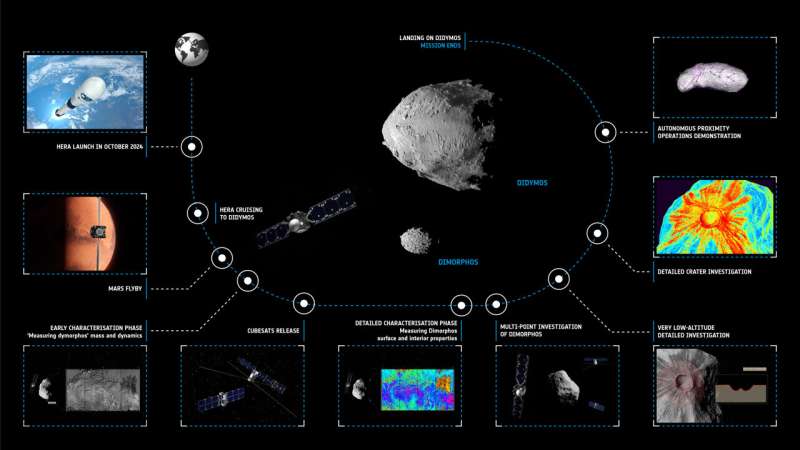This article has been reviewed according to Science X's editorial process and policies. Editors have highlighted the following attributes while ensuring the content's credibility:
fact-checked
trusted source
proofread
Hera and its CubeSats speak with mission control

ESA's Hera asteroid mission and its two CubeSats interacted as if they were in space, within the foam pyramid-lined walls of the Agency's Maxwell test chamber in the Netherlands. The trio communicated together, sharing data and ranging information at the same time as their Hera mothership received commands from its mission controllers at the European Space Operations Center in Darmstadt, Germany.
Testing took place inside the Maxwell electromagnetic compatibility chamber, part of ESA's ESTEC Test Center, the largest spacecraft test facility in Europe. Maxwell's 9-m high metal walls shield it from all external radio interference, while its interior foam pyramids absorb all radio waves from the space systems being tested. The result is a location that mimics the infinite void of space.
"Once the door of Maxwell is closed, this becomes the only place where we can operate the antennas of Hera and its two CubeSats together freely and safely," explains Hera CubeSats engineer Franco Perez Lissi.
"For the rest of the mission's test program telecommands were being sent to the spacecraft via cables instead. We already have detailed models of how the connection to Earth and the inter-satellite links between the satellites will work, but this testing allows us to validate these models against reality."
The testing extended to ESOC, allowing the Hera operations team based there to operate the spacecraft remotely, and downlink telemetry and data via Hera's 1.13-m diameter High Gain Antenna, exactly as they will once Hera is in space. At the same time Hera and its CubeSats were also communicating via dedicated inter-satellite links.
Manufactured by HPS in Germany and Romania, Hera's High Gain Antenna boosts its X-band signal more than 4000-fold in order to reach distant Earth. The S-band inter-satellite links connecting Hera and its CubeSats are much weaker, comparable to domestic wifi.
Based on software-defined radio, these inter-satellite links—supplied by Tekever in Portugal with antennas from Anywaves in France—do double duty: not only exchanging data with Hera, which serves as a relay back to Earth, but also supplying ranging information, letting the trio know where they are at any one time relative to each other, minimizing any risk of collision.
The multi-point Doppler data provided through these inter-satellite links will also enable a more accurate measurement of the gravity fields of the Didymos and Dimorphos asteroids than Hera could achieve by itself.
"By having everything transmitting directly through the air we've proved that all the links can run without interfering with each other," explains Hera communications systems engineer Paolo Concari. "We actually expected to see some minor degradation but didn't really find any—something called the 'coupling factor' where adjacent antennas can pick one another up—so ended up with very good performance."
The test campaign also took in the initial part-deployment of the CubeSats from Hera's topside Asteroid Deck: the pair will be extended out from their Deep Space Deployers one at a time, but will remain connected to Hera until their operations and radio-links are with Hera are confirmed by testing.

About Hera
Hera is ESA's first mission for planetary defense. Due for launch in October this year, Hera will fly to the Didymos binary asteroid system in deep space to perform a close-up survey of the Dimorphos moonlet in orbit around the primary body. The Great-Pyramid-sized Dimorphos is already historic, as the first solar system object to have its orbit changed by human activity, by the 2022 impact of NASA's DART mission.
Hera is intended to gather crucial missing data about Dimorphos for scientists, to turn DART's grand-scale experiment into a well-understood and potentially repeatable planetary defense technique. To increase its yield of data, Hera carries with it ESA's first deep space CubeSats, carrying additional instruments and planned to fly closer to the asteroid's surface than the main spacecraft, before eventually landing.
The Juventas CubeSat carries a radar instrument, to perform the first radar probe of an asteroid's internal structure, along with a gravity-detecting gravimeter. Its Milani counterpart hosts a multispectral imager to survey surface mineralogy as well as a dust surveyor.
Provided by European Space Agency





















